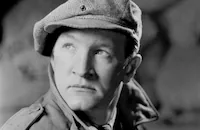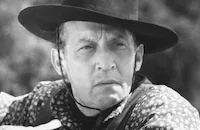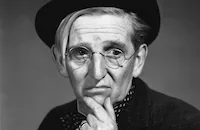Operation Haylift
Cast & Crew
William Berke
Bill Williams
Ann Rutherford
Tom Brown
Jane Nigh
Joe Sawyer
Film Details
Technical Specs

Synopsis
Bill and Clara Masters and their ten-year-old son Roy live in the rugged ranch lands near Ely, Nevada. Bill's brother Tom has recently returned from service as an Air Force pilot, and Bill is expecting him to help in the ranching operations. One day Bill and Roy are out hunting for a cougar, when they come upon some rustlers loading their cattle into a truck. After they capture the thieves and deliver them to the sheriff, Bill picks up a $5,000 reward from George Swallow of the Stockman's Association and makes plans to use it to buy more ranch land. Bill senses that Tom is unhappy and sends for Tom's girl friend Pat Rogers, whom he met when she was in the W.A.C. Tom and Pat soon marry and leave for their honeymoon in Tahoe, but, en route, meet Tom's old service buddy Max Maxwell and his wife. Max has rejoined the Air Force and is about to leave for Germany to fly in the Berlin Airlift. Max rekindles Tom's real desire to resume his flying career. Pat encourages Tom, but when when Tom tells Bill that he does not want to be a rancher and intends to resume flying, Bill is disappointed that Tom will not be helping with the expanding ranch operations. Nevertheless, Tom and Pat leave to join Max in Germany. Later, Bill gains a certain notoriety when a local newspaperman uses some of his comments about the political and social fronts in his column. Tom's tour of duty in Germany ends and he is transferred back to the U.S. After a severe drought in the summer of 1948, Nevada experiences its worst blizzard in fifty years. The U.S. Army sends special equipment, a state of emergency is declared and National Guard units from Nevada and neighboring states are called out. Many agencies pitch in to keep roads open, but many of the weaker sheep and cattle die of starvation and cold. George Swallow makes a conference phone call to all imperiled ranchers proposing to seek the Air Force's help in dropping hay where the herds can reach it. As the same plan had earlier proved unsuccessful in Wyoming and Utah, Bill opposes it, but the majority of the ranchers back it. George calls their senator in Washington and soon a fleet of C-82's, known as flying boxcars, begin to arrive at Fallon airport, and Tom, now a major, is scheduled to fly the first mission. After hay is loaded on board the plane, they take off for Ely, landing on an icy runway to pick up rancher Sandy Cameron, who will help them spot the best drop sites for his herd. The first flight is a great success and, while President Harry S. Truman requests emergency funds for the ranchers, the 62nd Troop Carrier Group continues its haylift operation. Meanwhile, when Bill attempts to take a load of hay to his herd, his tractor gets stuck in a snow drift. He is too stubborn to seek help from the airlift, although Tom is only one of eighteen pilots flying the missions. When Roy tries to take off in his father's truck to get help, he crashes and suffers a minor bump on the head, then tells his father that he still cares about the ranch, even if he does not. Roy's comment causes Bill to reconsider his actions but, as the phone lines are down, he has to ride on horseback into Ely for help. George puts him to work scheduling the various flights. Later, when an inexperienced pilot radios that he feels that it is too dangerous to make a drop over Bill's land, Tom offers to make the flight. Bill refuses the offer, but George, who is in charge, tells Tom to go ahead. After Bill decides to go along, the flight is a success, and the two brothers reconcile. At a celebratory dinner for the pilots, Bill admits that he was wrong and states that the thousands of tons of hay dropped over an area of 85,000 square miles probably saved a million head of cattle and two million sheep.

Director
William Berke
Cast

Bill Williams

Ann Rutherford

Tom Brown

Jane Nigh

Joe Sawyer

Richard Travis

Raymond Hatton

James Conlin
Tommy Ivo
M'liss Mcclure
Dean Riesner
Frank Jaros
Joanna Armstrong
Dink Dean
Capt. H. G. Fisher U.s.a.f.
M/sgt. Victor Rogers U.s.a.f.
Sgt. William Dooms U.s.a.f.
Roger Norton U.s.a.f.
Crew
Alfred Berke
Mary Chaffee
Marty Crail
Harry Eckles
Capt. H. G. Fisher U.s.a.f.
Frank Fox
Frank And Imbach
Russell Garcia
Orville Hampton
Richard Hazard
Benjamin Kline
Murray Lerner
Robert L. Lippert
Ray Mercer
Nat Merman
C. O. Morris
Al Myers
Carl Pierson
James Punter
Dean Riesner
Harry Ross
Joe Sawyer
Joe Sawyer
Betty Sinclair
Harry Smith
George N. Swallow

Film Details
Technical Specs

Quotes
Trivia
Notes
The opening credits include the following written prologue: "This production was photographed entirely in Ely, Nevada and was made possible through the cooperation of the Department of Defense, U.S. Air Force and the Department of Agriculture."
In January and February 1949, much of the U.S. experienced very severe weather conditions. Several of the western states, including Nevada, Wyoming, Utah and Montana, had the worst blizzards in Weather Bureau records, and it was feared that livestock losses might total five million dollars. According to a January 7, 1949 Los Angeles Times article, the U.S. Air Force assigned eighteen C-82 troop carriers to Nevada and the Rocky Mountain region to drop bales of hay close to starving livestock. The operation was supervised by the Federal Works Administration, and the ranchers were not charged for the emergency flights.
According to a September 6, 1949 Hollywood Reporter news item, this picture was the first to be personally produced by Murray Lerner. Although the Daily Variety review credits Frank Fox as associate producer, he is credited onscreen as assistant director. On March 16, 1950, Hollywood Reporter reported that Lippert Productions was planning to promote the picture by recreating in miniature the original Rocky Mountain haylift by dropping 10,000 tiny bales of hay in that area. According to a April 7, 1950 Hollywood Reporter news item, a flying contingent from Wright-Patterson Field joined in the premiere festivities in Ely.












